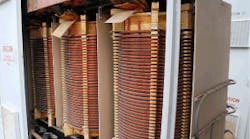I’m sure many readers would question why anyone would want to perform a relatively expensive insulation power factor test on an inexpensive transformer. Typically, if any testing is done, it will be an insulation resistance test or polarization index (PI), especially on units rated less than 167kVA (single-phase) or 500kVA (3-phase). The additional costs associated with performing insulation power factor testing on these smaller units are difficult to justify. However, larger dry-type transformers — especially ones that provide critical power — should be given a power factor test to ensure continued serviceability.
There are two general types of dry-type power transformers: ventilated and non-ventilated. A ventilated dry-type transformer (Photo) is constructed so that ambient air can circulate through the core and windings to cool them. Non-ventilated dry-type transformers are constructed so that no additional cooling is created by ambient air circulation.
Dry-type transformers operate at much higher temperatures than their liquid-insulated counterparts. For example, a typical oil-filled transformer has a rated temperature rise of 65°C. This rating is the temperature rise above ambient. Because dry-type transformers have no oil (or other liquid) that can cool them during operation, they must be constructed of materials that can withstand higher temperatures without damage. Dry-type transformers can be constructed of Class B (130°C), Class C (220°C), or Class H (180°C) materials, and can be a combination of Nomex, mica, fiberglass, asbestos, wood, or similar materials. Smaller transformers may be epoxy-encapsulated to provide mechanical strength, whereas some larger units may be encapsulated to prevent moisture intrusion into the insulation, especially if used outdoors.
Power Factor Test Voltages
Corona can be a problem when testing dry-type transformers, so it is recommended that a power factor test be conducted at a lower voltage (something below the corona inception point) and then at the normal test voltage. If the low-voltage test result is satisfactory, then the test can proceed at the normal test voltage. If the power factor rises with an increase in voltage, however, corona is indicated. Running the lower-voltage test first will reduce the possibility of corona damage from occurring. As noted in “Power Factor Testing of Dry-Type Power and Distribution Transformers,” by E.J. Maritolli and R. Levi, Doble Engineering Co., you should apply the test voltages shown in Table 1 (click here to see Table 1) when performing a power factor test.
A transformer’s power factor versus voltage characteristics can be helpful in troubleshooting a suspect unit. Increase the voltage in several steps, and record the percent power factor on graph paper (Fig. 1) (click here to see Fig. 1). A characteristic that is flat (Curve No. 1) indicates no appreciable ionization. Power factor tip up, where the percent power factor increases with voltage (Curve No. 2), indicates the presence of voids or ionization within insulation. If the tip up occurs below the operating voltage, this could spell big trouble in the near future. If a tip down is measured (Curve No. 3), it could indicate a missing core ground or possibly surface moisture.
Increasing the voltage could eliminate the tip down by drying the surface out. Doble Engineering states that test voltages up to 125% of the operating voltage can usually be applied to conduct this test. However, many of our customers will not allow us to apply more than rated voltage to any winding.
The Effects of Temperature
Although temperature can affect the power factors of dry-type transformers, there are too many different types of insulation to assemble a standard temperature correction chart. At this time, Doble believes that temperature may not be a significant factor in dry-type transformers. Because the major insulation component is air, the temperature characteristic curve should be fairly flat. At one of Doble Engineering’s fall meetings, there were a number of companies that stated that temperature did affect the power factor, but not in a uniform way from transformer to transformer. This just reinforces the difficulty in developing a standardized temperature correction chart for dry-type transformers. As with all tested devices, if the test results are questionable at high temperatures, allow the unit to cool and retest when its temperature is closer to 20°C.
Analyzing Test Results
The best possible evaluation of power factor test results is by comparing them to the baseline results of the specific unit. Baseline tests are performed when the unit is first installed using the same (or similar) field test equipment under the same conditions that the tests will be performed in the future. Sometimes, no baseline results are available, so the results can be compared to like units tested under similar conditions or with the factory test results, if available. Some manufacturers do not perform a power factor test as a standard test, but will do it if it’s requested.
Capacitance should be recorded whenever a power factor test is performed. If the capacitance changes, it would indicate deterioration of the insulation or possibly winding movement.
What are acceptable insulation power factor readings for ventilated dry-type (power and distribution) transformers? These values are considered acceptable:
| CHL (high-to-low) | 2.0% | 84% of reported units |
| CL (low-to-ground) | 4.0% | 75% of reported units |
| CH (high-to-ground) | 3.0% | 85% of reported units |
Note that these power factors are based on the majority of the units tested falling at or below the recommended percent power factors listed. It is possible that a transformer could exceed these values and still be serviceable. A transformer that exceeded these values would be marked as needing further investigation to determine why the insulation power factor was higher.
In tabulating these results, Doble excluded “high contributors.” A transformer was considered to be a high contributor if its results caused the average to be increased significantly. All results are for service-aged transformers. A service-aged transformer is one that has typically been in service for at least five years.
What are acceptable insulation power factor readings for epoxy-encapsulated type (power) transformers? These values are considered acceptable:
| CHL | 1.0% | 96% of reported units |
| CL | 2.0% | 90% of reported units |
| CH | 3.0% | not reported |
Doble does not have enough data to allow recommending maximum values for epoxy-encapsulated distribution transformers. They commented that 83% of the reported distribution transformers were from one manufacturer and had CL power factors of nearly 8%.
Test results may be affected by remote temperature devices (RTDs) imbedded in the winding (winding temperature indicators). If the CHL results are higher than anticipated or are negative, the ground lead from the RTD should be disconnected and the unit retested.
ANSI/NETA MTS-2011, “Standard for Maintenance Testing Specifications for Electrical Power Equipment and Systems,” recommends the values shown in Table 2 (click here to see Table 2) for dry-type transformers.
Test Connections
Standard test connections are used for power factor testing dry-type transformers.
- Grounded specimen test
- Guarded specimen test
- Ungrounded specimen test
The grounded specimen test and the guarded specimen test are repeated for the low-voltage windings, being careful not to exceed their rated voltage. Fig. 2, Fig. 3, and Fig. 4 illustrate the high-side connections to be made for each of these tests. Note that there are two paths for the current to follow: winding-to-winding and winding-to-ground. Any current that enters above the meter is not measured. The guarded specimen test and the ungrounded specimen test are both examples where one current or the other is routed above the metering and is “guarded” (i.e., not measured).
Field Experience
Our field service technicians typically test three primary types of transformers (based on their primary insulation): Nomex, Mica, and epoxy cast coil. The majority of the units tested are the Nomex insulated type. The Mica insulated ventilated transformers are approximately 6% of the total.
With the Nomex insulated transformers, we typically see less than 5% power factor, with most units testing between 2% to 3%. Mica insulated transformers can have considerably higher power factors, especially if they have been in a high humidity area and de-energized. We have seen initial power factors of up to 20% in this situation. Drying the transformer using heaters can reduce this to 5% or less. Epoxy cast coil transformers generally test well, with most being in line with Doble recommendations.
Potential problems can be caused by dirt buildup in between the high and low winding at the insulating blocks, which separate the windings from the frame bottom. The power factor often can be reduced by 50% simply by a thorough cleaning at this point. Another problem we have seen is that the leads going from the transformer to the line-side of the switch are often twisted to the extent they have inadequate clearance between cables. This can cause higher than expected % power factor readings, and can cause problems when performing an excitation test (getting the leads mixed up).
Some smaller transformers (and fewer larger ones) may have an electrostatic shield between the high and low windings. On transformers with this shield, the CHL test cannot be performed, as the shield is grounded. The tests are limited to performing the CH and CL tests. This shield also has caused problems when performing a transformer turns ratio (TTR) test using some digital ratiometers, but not when an analog TTR is used.
The capillary tubes used for RTDs can also be a problem with dry-type transformers. They are often held in place by a nylon cable tie. If it is a high-temperature cable tie, there usually is no problem. However, in at least five cases recently we have encountered transformer failures due to this tube falling onto the winding and causing a short. There have been many more cases where the cable tie was clearly close to failure. Our practice is to replace all cable ties with clamps to eliminate this problem.
Lastly, a good number of transformers have been found with the shipping bolts still in place and secured, which causes high noise and vibration in the unit. Leaving the bolts in place, but loosening them, eliminates the noise and vibration while protecting the core from shifting if it ever needs to be relocated.
Solid-Porcelain and Epoxy Bushings
Doble recommends power factor testing solid porcelain and epoxy bushings rated above 5kV by the hot-collar method. For low-voltage bushings, or bushings with three petticoats or less, it is recommended that the collar be placed below the top petticoat. Bushings with more petticoats should have the collar placed below the top petticoat and then another test run with the collar one petticoat above the flange. When performing a hot-collar test, be certain to keep the high-voltage probe at a 90° angle to the bushing and seat the collar as closely to the surface as possible. Figure 5 shows the hot-collar test connection arrangement.
Capacitance should be ±10% of the average of all bushings of the same type. A fluctuating watts/milliwatts reading indicates a crack in the petticoat. Watts-loss readings above 0.10W using the 10kV test set or 6.0mW using the 2.5kV test set should be investigated as to their cause. This value is quoted by Doble for both solid porcelain and epoxy bushings.
In Summary
Power factor testing is recommended on large (greater than 500kVA) transformers to ensure insulation integrity. Although we’ve presented some general recommendations for smaller dry-type transformers, there have not been an adequate number of test results on a broad sampling to verify the effects of temperature on insulation or to provide definitive values for smaller encapsulated type units. Most of these smaller units are probably adequately tested using megohmmeters and performing PI and/or insulation resistance tests. But a power factor test can provide good insulation grading and help detect any deficiencies, which may affect reliability on all sized units.
White is director of training for Shermco Industries in Irving, Texas. He can be reached at: [email protected].
Note: Although White is a member of the NFPA 70E, NFPA 70B, and ASTM F18 technical committees, his opinions are not official interpretations. Readers should have copies of these standards so they can read them in their entirety.



